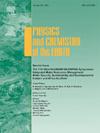Performance of sulfate species on limestone powder concrete under low temperature pulse current
IF 3
3区 地球科学
Q2 GEOSCIENCES, MULTIDISCIPLINARY
引用次数: 0
Abstract
The leakage phenomenon of subway trains in urban subway systems can accelerate the erosion and damage of concrete structures, which has adverse effects on the safety and service life of the project. This study aims to evaluate the erosion effect of sulfate solution on concrete by simulating the low temperature pulse current conditions on subway tracks. The erosion mechanism of sulfate solution on limestone powder concrete under low temperature pulse current was revealed through macroscopic methods such as surface morphology observation, compressive strength testing, and sulfate ion content analysis. Further analysis of the degradation mechanism was conducted using SEM, porosity measurement, and microhardness testing. The results showed that pulse current promoted the migration and enrichment of SO42− towards the cathode in limestone powder concrete, forming a large amount of hydration products such as Mg(OH)2, gypsum, and ettringite, which blocked the pores. Although the impact of sulfate type on quality loss is limited, the compressive strength of all test blocks usually decreases, with a compressive strength loss rate of 22.8% for the C1 group of cubic test blocks. During the erosion process, the content of SO42− decreases with increasing depth, and there is almost no SO42− in the center of the test block. The porosity decreases with erosion depth, and the anode region is higher than the cathode. The damage caused by sulfate erosion does not differ significantly between different solutions, but the hardness of the anode is slightly higher than that of the cathode.
求助全文
约1分钟内获得全文
求助全文
来源期刊

Physics and Chemistry of the Earth
地学-地球科学综合
CiteScore
5.40
自引率
2.70%
发文量
176
审稿时长
31.6 weeks
期刊介绍:
Physics and Chemistry of the Earth is an international interdisciplinary journal for the rapid publication of collections of refereed communications in separate thematic issues, either stemming from scientific meetings, or, especially compiled for the occasion. There is no restriction on the length of articles published in the journal. Physics and Chemistry of the Earth incorporates the separate Parts A, B and C which existed until the end of 2001.
Please note: the Editors are unable to consider submissions that are not invited or linked to a thematic issue. Please do not submit unsolicited papers.
The journal covers the following subject areas:
-Solid Earth and Geodesy:
(geology, geochemistry, tectonophysics, seismology, volcanology, palaeomagnetism and rock magnetism, electromagnetism and potential fields, marine and environmental geosciences as well as geodesy).
-Hydrology, Oceans and Atmosphere:
(hydrology and water resources research, engineering and management, oceanography and oceanic chemistry, shelf, sea, lake and river sciences, meteorology and atmospheric sciences incl. chemistry as well as climatology and glaciology).
-Solar-Terrestrial and Planetary Science:
(solar, heliospheric and solar-planetary sciences, geology, geophysics and atmospheric sciences of planets, satellites and small bodies as well as cosmochemistry and exobiology).
 求助内容:
求助内容: 应助结果提醒方式:
应助结果提醒方式:


